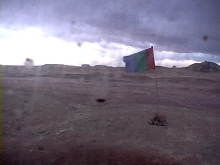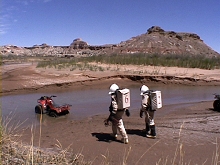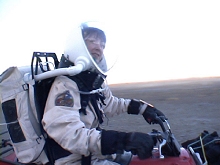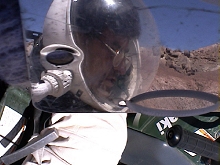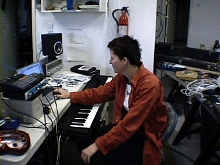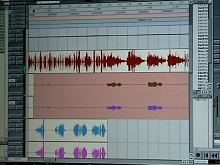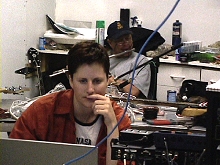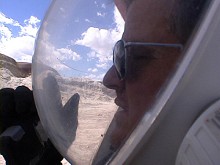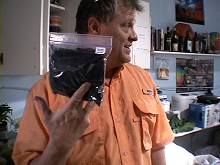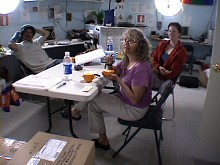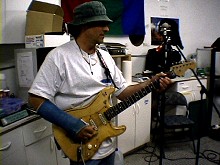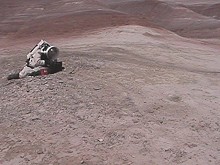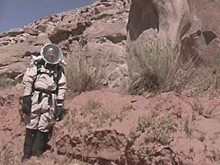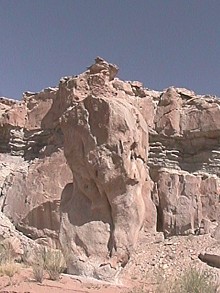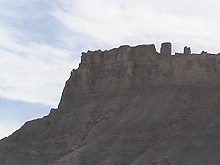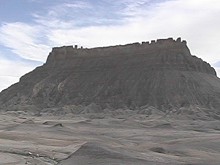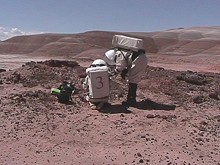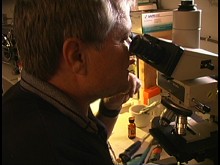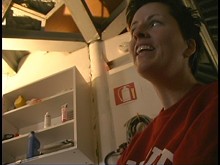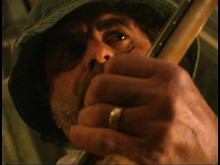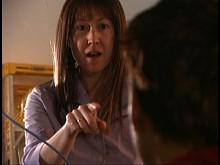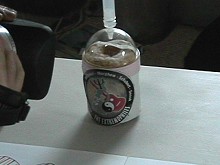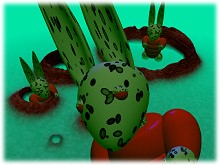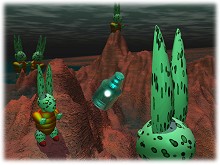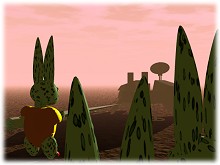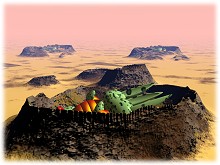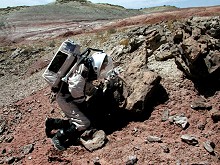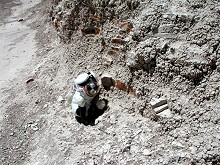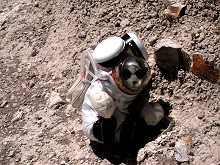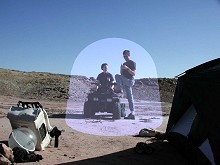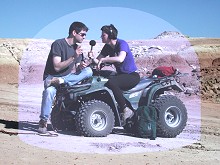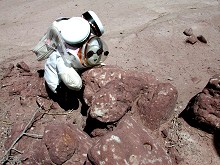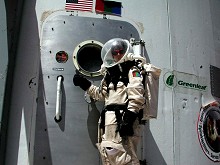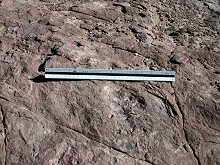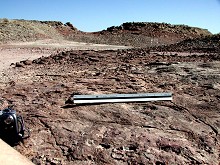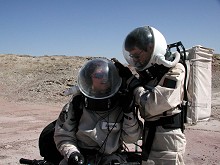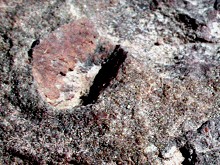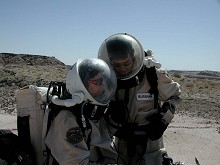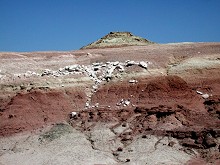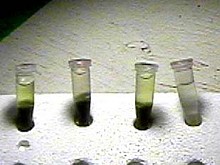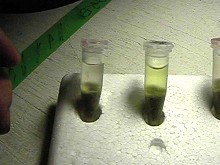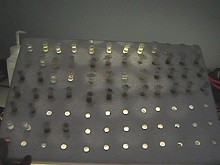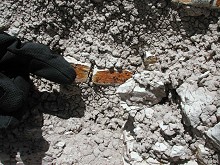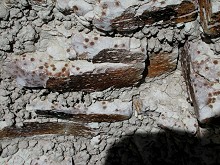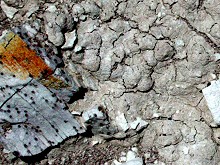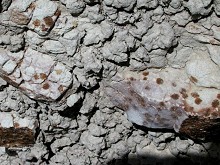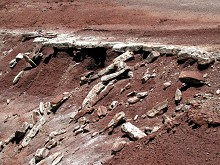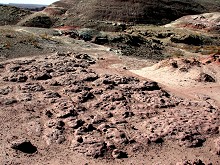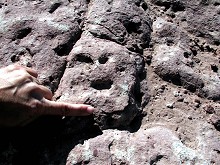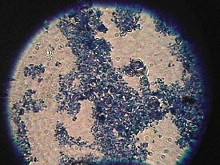Crew 6 - Crew Reports
Contents
April 24, 2002
Science Overview - Penny Boston
Coupled Mineralogy & Geomicrobiology in Hot & Cold Deserts on Earth and Mars
Primary Questions
Do desert surface rinds reliably record climatic conditions?
Are desert surface rinds indicators of microbial activity?
Do surface materials and processes in deserts indicate anything about the subsurface mineralogical, hydrological, & microbial conditions?
Primary Hypothesis
We suggest that the chemical and microbial processes that occur in surface desert varnish and other arid land weathering rinds are related to the pedogenic (soil-building) and geomicrobiological processes that we are studying in arid land caves.
We propose that a set of fundamental processes (e.g. the formation of clays, chemical formation of oxides of Mn, Fe, and Rare Earth Elements, and microbial activity) occur in both environments (surface and subsurface).
We predict that the production of characteristic thin surface rinds is produced by the action of weathering, diurnal and seasonal thermal oscillation, and possibly insolation on the above set of fundamental processes. The fluffy, low-density subsurface cave materials (known as corrosion residues) are due to long-term stable thermal and humidity conditions, and the absence of weathering factors on those same fundamental processes. Because of the perceived relationships between surface processes and subsurface analogs, we are provisionally renaming cave corrosion residues "speleosols", i.e. soils formed in caves.
Science Context of MDRS Mission Within Existing Studies
My science agenda for MDRS is to try to identify and characterize surface processes that have microbial significance and may also reflect related subsurface processes (e.g. in caves, voids, aquifers, and shallow subsoils). In particular, manganese and iron oxide desert rinds and surface carbonates are relevant to Mars and we are actively studying related materials in arid land caves.
Specific Science Goals
- Locate desert varnish and other oxide rinds, carbonate and other lateritic surface deposits with potential microbial communities (active or fossil remains).
- Survey potential microniches for organisms, e.g. rock cracks, larger fissuring, subsoil layers, undersides of unattached rocks, etc.
- Conduct yes/no in situ activity tests for the presence of enzymes extruded into the environment by microbes (exoenzymes). Followup quantitative work in future missions.
- Produce a combination geological/mineralogical/bioactivity map of selected subsites.
- Collect materials for future study (functioning as a human "sample return" mission) a. sterile hand samples of materials b. SEM mounts on stubs c. enrichment culturing to isolate organisms of specific types d. frozen samples for later DNA analysis
- Photodocumentation of sites, textures, appearance.
EVA Activities
- Walking reconnaissance
- Exploring with rock hammer
- Digital photography
- Mapping, sketching, surveying in points etc.
- Testing for carbonates (HCl)
- Grab sampling of (rocks and unconsolidated materials)
- Microsampling (scraping of rinds, digging out material from cracks, etc.)
- Preservation samples (in glutaraldehyde)
- Baseline data acquisition (e.g. temperature, humidity, etc.)
- In situ exposure experiments
- Inoculating culture media with samples
- Collecting DNA samples on dry ice at very end of mission tenure
Environmental Materials of Interest
- Desert Varnish on surface rocks
- Undersides and cracks in varnished rocks
- Desert Pavement, Cemented or semi-cemented
- Paleosols (if any)
- Surface Carbonates (caliches, efflorescence crusts, etc.)
- Other weathering and oxidation rinds (e.g. dendrites, clays, etc.)
- Cryptogamic soils (desert soils bound by microbial filaments and polysaccharides)
- Any volcanic materials, e.g tuff, ash, lava, etc., especially those with surface rinds
- Putative lakebeds or playas
- Tafoni in any rock type, e.g. sandstones mostly
- Travertine deposits (both ancient and active)
Personal Journal - Sam Burbank
April 23, 2002 - It's a long drive from SF to Hanksville Utah. I arrived on Tuesday evening around midnight. A call home to report being safe, then the drive trough the sparely populated, long and thin town. A couple of more miles to the turnoff I hoped I'd remember from working on the hab in December. The moon was rising and the winding dirt road visible. So tired. What were we doing here?
I expected to find my crew members there, to turn a corner (many corners to turn) and find a lit place, see their truck, last man in. But every corner was dark, dark red rock with streaks of white or gray running through them.
I'd been here before, and knew the hab is tucked away from the main road. It's visible but not obvious, and so I slowly turned each corner, flashlight in hand. Is that the hab or a big rock? No...yes, there is was, but totally dark. The hab. I saw most of the frame go up in December, but none of the walls or roof. Now here it was, so much taller than I imagined (same impression with the hab on Devon Island), and lit only by moonlight, the only sound coming from the torn wall of the next door greenhouse flapping in the warm breeze.
I walked around the thing three or four times. Where was everyone? Was it open? It was. Peaked in through the airlock, flashlight darting around as if in a low budget sci-fi film. There were the used looking suits, hanging empty, one with a marker pen taped to the sleeve, one with a mission patch from the last rotation, crew 5, stuck to the chest. I moved further inside, now into the science room. It looked just as lived in, as if when I came in the front, the inhabitants slipped out the back. I found myself quickly turning around with the flashlight, expecting some movement behind me.
Up the stairs to the living room: plants, coffee maker, table and chairs. Someone's home. What to do? My crew would be here soon, so I would just wait.
There was an unlit candle on the main table (no power anywhere in the hab), so I lit that and brought out my luggage and miscellaneous gear, and loaded it all upstairs. Then I pulled out my guitar (part of one of our main experiments) and quietly strummed, the little candle glowing, moonlight beaming through the roof window, creating a pool of light on the floor to my right. Would they come tonight?
An hour of so went by, and soon it was past 2:00AM and it was time to go to sleep in this dark little hab. I picked a stateroom (choice of 6!) and loaded my stuff in there, assuming the others would come in soon, but they never did that night. I woke up alone in this now clear and bright spaceship, made a cup of coffee, felt very much like a character in some lost twilight zone episode: Alone on Mars!
So an unexpected little one man simulation. I drove back to town and found two of our crewmembers, Penny and Steve, driving in with a truck load of gear, met them. And then stuck with them, and have been with them since.
There is plenty of room here in the hab for all if everyone is mindful of the others. Still, I'll always remember my first night in the MDRS, alone on some planet, a planet with lots of time for guitar playing, and a big beautiful moon, happy to illuminate a lone abandoned research station, and happy to have new company.
April 25, 2002
Captain's Log - Frank Schubert
We are nearing the end of the first day of simulation for crew six at MDRS. It was hectic as expected. Settling into the hab takes time and this crew was no different. We are impressed by crew fives fidelity and reporting and plan to carry on with that tradition.
As an example, we are fueling the generator while in suits. By being careful and slow it is possible to do the job without getting any gas on the suits. Of course, everything takes longer in the suits.
Last night we discovered that the toilet was malfunction and about to overflow. Steve volunteered to empty it and with the help of Sam he was able to dispose of most of the waste. The odor became overpowering and we had to open the doors and put the fan in the portal on the roof blowing the smell out the doors. In the morning when the fan was off the odor returned and we made the decision to take the toilet out and go to a camp toilet. Our local contact had donated five chairs and we modified one to work as the toilet. Again, Steve and Sam went to work and removed the offending toilet. The hab now smell fresh and spirits had lifted considerably.
The new water pump also malfunctioned after one use. We replaced it with the pump that was intended for the emitter field. This is not a problem as the warm weather and the wind have made the leach field work well.
Kelly has been a little bit under the weather and she has spent most of the day taking it easy. She seemed better in the afternoon.
Ephimia has been a real source of information on the ISS as she works in the human factors directly. We are all amazed at how much our problems parallel those that the astronauts are having. Like us, they also have power problems and have to cook with limited power. They also have odor problems. This all makes us feel like a real crew.
The crew is taking personality tests today. Ephimia is studying the human factors of a Mars crew for Johnson Space Center and we are all curious to see how we score on these tests.
Today's EVA was done by Steve, Penny. It was a scouting EVA with Steve taking Penny to Lith Canyon. During the trip back, Penny was making a turn and got her boot stuck on the shift lever. Then her glove caught on the handle and she took a spill. When she got back to the hab she was quite sore but ok for the most part. She will be sore for a couple of days but will be ok. Lucky for her I brought my pain pills from my accident.
Sam, Kelly and Frank worked on setting up the recording studio. We had already set up a smaller digital recorder and had already written several short riffs. We plan to start collaborating with the musician's back on Earth this weekend.
Ephimia, Sam and Steve are handling the cooking chores with grunt help from Frank. Tonight after the reports we plan to watch a movie and hit the sack early for a big day of science and music tomorrow.
More later.
Proposed Schedule - Crew 6
| 07:00 | Crew wake |
| 07:30 | ATV training for new crew |
| 08:30 | Breakfast |
| 09:00 | Psych study briefing and instructions |
| 09:30 | Commence IVA activities
|
| 14:00 | EVA preparation |
| 15:30 | Prebreathe |
| 15:50 | Begin EVA
|
| 18:00 | End EVA |
| 20:00 | Report preparation |
| 21:00 | Scheduling and ops (daily planning) meeting |
| 22:00 | Presleep activities |
| 23:00 | Sleep |
Biolet Replacement - Crew 6
Dispatch to Mission Support: 04/25/2002 - 09:21
Mission support:
After several hours of miserable work cleaning the overflowing biolet, beginning at 12:30am, ending at 2:30am, the crew has decided to remove the biolet from the habitat. The stench filling the habitat poses serious crew health, safety, morale, and productivity risks. The biolet apparently hadn't been emptied during Crew 5, and possibly never. Crew 6 emptied 5 full trays (approximately 80-100 lbs/36-45 kgs) of excrement, and it is still half full.
We will be constructing our own toilet and using plastic bags to contain our waste.
Crew 6
Engineering Report - Kelly Snook
Dispatch to Mission Support: 04/25/2002 - 20:54
Water Pump Failure - The second water pump seems to be functioning, but not with enough power to pump water up to the tank on the upper deck. One crewmember has gone in search of another pump with the goal of resuming sim tomorrow with a new pump.
Biolet Failure - The biolet was successfully extracted from the habitat today and the bathroom was swabbed down several times with mops, sponges, disinfectant, and water. This was a several hour process requiring breaking of sim to dispose with the biolet and its waste. A new toilet seat using the bag method will be built for use during the rest of the mission.
Issues for Mission Control:
- Please advise what to do with the 200 lbs/90 kg of human waste currently in the back of the pickup truck
- Please advise what to do in the future with the bags of waste that will be produced, as we have no agreement with the city for disposal of human waste.
Computer Connectivity - no crewmember has had success connecting their individual laptops to the internet. We have been able to "see" the network by obtaining IP addresses from the server, but no one has been able to get out to use the internet or check e-mails. Issues for Mission Support: Any advice from previous crewmembers (especially Bill Clancey or Crew 5) would be most welcome.
Radio Equipment - there are only two functioning headsets for EVA. EVA was conducted today with one crewmember using a handheld radio talking through the helmet. Please send new functioning radios before our overnight EVA currently scheduled for May 4th.
EVA Equipment - Boots and gloves were too large for P. Boston. Boots were several inches too long and resulted in ATV accident. Crew are OK, but this is a serious issue that should be addressed for safety reasons. Smaller boots and gloves should be available for smaller crewmembers.
ATVs - One of the small Kawasaki ATVs was overturned today due to the oversized boots. No serious injuries, but handlebars are bent. No action necessary by Mission Support. Repairs will be made by crew engineers.
Habitat Chairs - Current chairs are inadequate. They break at a very high rate and there are currently at least 8 broken chairs on the premises. MS should stop buying this brand of chairs. New chairs have been donated to the hab by L. Ekker, so there are enough until the rest of the green folding chairs break.
Kitchen Tools - Please advise on status of hotplate purchase and shipment. Crew meals have been planned and shipped by the Natural Epicurian Center in Austin, and require heavy preparation. Aside from the hotplate, we need another non-teflon steel frying pan, tupperware, serving utinsils and more serving dishes.
EVA Support - One Maintenance EVA is planned for tomorrow evening to install the new generator, and to do minor repairs on the greenhouse, including watering plants. Request advice from Mission Control regarding whether it's desirable to try to repair the solar water pumps and other greenhouse systems.
Crew 6
April 26, 2002
Captain's Log - Frank Schubert
Today we all got up on schedule and started the day with cleansing tea (yuck) and something that looked like rice and tasted great.
By 08:30 we were planing the day and checking the Mission Support messages.
The mood of the crew has improved tremendously since we removed the biolet toilet.
The hab is now almost odor free both upstairs and down. A throne was made out of one of the seats donated by Larry Ekker and it works well. We keep the bathroom fan on most of the time. I am amazed at how odor affects the crew. I felt a general lack of energy yesterday. Today the spark is back for Crew 6.
The musicians tested the acoustics of the hab and the consensus is that we will just record everything in the lab. We will hook up with Mutato Musica (Devo Studios) in Los Angles and Submarine Studios in San Fransico this weekend. Kelly, with help from Frank spent several hours setting up the studio. Kelly also spent a lot of time getting the Internet connection working. We have some tricks to squeeze more music though our ailing Internet connection and plan to use them all. We started recording in the afternoon and it is as special as I have ever seen. The excitement level is very high. Today we recorded two songs we wrote, "I Am Going To Mars," "M.F.C.," and one cover song, "Under the Milky Way." We will send them out tonight and see what the musicians do with them. During one track, Steve came down and built Crash, (aka Penny Boston) a footrest. Kelly sampled it and put it in the song. Quite cool.
Kelly is turning out to be a top flight engineer. She is quick and accurate. Sam and I consider us very lucky. We were worried that the rest of the crew might get sick of hearing the same song several times. They seem to really like it. The music has a very positive affect on the crew and morale rose as we created the music. Ephimia is taking note.
The wind picked up this afternoon. Personally, I like the wind. The hab is rock steady in the wind. The weather pole squeaks and moans as the wind whistles past the satellite dish. By six the wind was blowing fiercely. This is typical for this area. A storm blew over as we watched the Moon rise. This is also typical. The rain clouds pass over Hanksville and don't leave a drop.
Steve and Sam did a long maintiance EVA today. They worked on the ATV that Crash had the mishap with. They also hooked up the third pump. That one burned out in three minutes. Steve brought it in and he is going to take the three pumps that don't work and try to make one that does. Failing that, we will run the hose in to the first floor. The emitter pump works to the first floor. We will then bucket brigade the water up to the holding tank.
Ephimia has given us all personality tests. I want to know if I passed but she won't tell me. She is gaining a lot of data from this crew. Apparently we are acting a lot like the crew on ISS.
The food experiment seems to be a success. We are all feeling good and have lots of energy. More on that from Ephi.
Steve continues to be the man when it comes to fixing things. He has repaired the pump, made a second recording table, and has also worked out a way to fill the jenny cans in the suit. That is helping out sim. No one has been out without a suit since yesterday and we hope to keep it that way.
Penny did a great job with the computers today. She got the network up and running and now we can have three computers on the Internet at once. She is a bit sore today and so we put off the science EVA for one more day. I felt a little guilty that we got so much work done on the music today. We plan to hit the science hard tomorrow and make up for the lost time. Tomorrow morning Ephimi and I are going to find the spot I found two months ago that has a large amount of deseart varnish. We will bring back several samples.
Keeping a schedule is the hardest part of the day. We start out on schedule and by the middle of the day we are behind. Today it was the computers and the comms for Kelly and Penny. For Steve, Sam and Frank it was getting the water pump working. For Ephimia it was food preparation. These tasks always seem to take longer, no matter how much thought and preparation we do. Ephimia has told us the on ISS it is the same problem. This crew is learning to adapt and constantly improving out scheduling. There will be more in this subject.
Proposed Schedule - Crew 6
Goals for the day:
- Studio set-up, music tests
- Generator install
- Greenhouse maintenance
- 04/27 Science traverse planning, study waypoints
- GIS computer install
| 07:00 | Crew wake |
| 07:30 | Breakfast preparation |
| 08:00 | Breakfast |
| 08:30 | Day planning briefing |
| 09:00 | IVA operations - studio set-up, toilet seat construction, science lab set-up, GIS computer install |
| 10:00 | Begin lunch preparations |
| 10:00 | Crew exercise (2 hours for non-EVA crew) |
| 12:00 | Lunch |
| 12:30 | Afternoon IVA operations - continue morning ops |
| 16:00 | Dinner preparation |
| 18:00 | Dinner |
| 19:00 | Maintenance EVA - GreenHab and Generator |
| 21:00 | End EVA |
| 21:30 | Evening planning meeting |
| 22:00 | Presleep activities |
| 23:00 | Sleep |
Engineering Report - Kelly Snook
Urgent Issues:
Waste - We do not believe that burying the waste is a viable solution. It is neither environmentally responsible nor physically feasible to dig that big of a hole. The biolet is not functioning enough to handle the waste. This is also not a good solution because the biolet would have to be located right next to the habitat (for power) and would have to be continuously manned.
We're laughing a lot about this, but these are serious issues that need to be addressed immediately!
Water Pump - Both new water pumps in the last 2 days have blown out. One crewmember drove to Grand Junction yesterday to buy the second pump, which failed immediately (within 5 minutes) today on EVA installation. This brand and size will not work to overcome the pressure head. Please confirm receipt of this message tonight and fedex us a water pump tomorrow. If we do not have a pump, we face at least an hour a day of water portage, which is unacceptable given the ambitious scientific agenda of this mission. The water pump should have the following specifications:
- > 1.5 HP
- Standard size fitting (1.5") - rig it up so it has male garden hose fittings on both ends
- Capable of establishing a pressure head of water at a height of at least 40 feet in a .75" hose
- Capable of running on 20 Amps or less
- If the pump is not submersible, make sure it has a pickup filter (brass mesh)
If Mission Support (or HQ) cannot fedex us the pump tomorrow, we will conduct a FULL SIM EVA to Home Depot in Grand F. Junction (on film) on Sunday. The analog here would be driving a rover to a previous landing site and pillaging the reckage.
Radios - We have a 4 person overnight EVA scheduled for next week. We are going to need functioning radios for that. The answer to your question about the radios is yes…the headsets are here, but only two are functioning.
Other Issues:
EVA Suits - 3 Suits were cleaned today (full of dirt, rocks, tape). 3 suits remain to be cleaned. Two helmets lack connection hardware for air supplies. Currently 4 helmets are are functioning. At least 3 backpacks are functioning. QUESTION: Are the helmet parts available somewhere in the habitat?
Computer Connectivity - After about 20 man-hours of concentrated effort, we were finally able to connect our laptops. The documentation on this procedure is severely lacking in the hab. Especially troublesome was the fact that when the settings on the main HabCom got accidentally changed, there was no documentation on how to set those up. The only documentation we could find for that required logging onto the internet. More documentation is necessary - at the very least, the Starband manuals or other supporting information.
ATVs - Damaged ATV was repaired successfully on EVA. All damage was cosmetic. QUESTION: Is there an ATV manual?
Toilet - A new toilet was constructed by cutting a hole in one of the folding chairs, in which plastic bags will be used for depositing solid waste.
GreenHab - Plants were watered today, but no significant work was done on any of the greenhouse systems.
Recording Studio - Music recording studio was successfully set up today and the first song recorded. Song will be sent to remote studios tonight and some delayed-live collaboration will occur with the SF studios. First attempts will be made to use the online collaboration software.
EVA Details:
We had 3 EVAs today, all for Maintenance.
Today's first EVA commenced at approximately 11am. This was designated M-1, devoted exclusively to maintenance tasks. Steve McDaniel and Sam Burbank were the EVA contingent and Frank Schubert on IVA assisting them.
EVA mission objectives were:
- To install Flotec water pump in outside reservoir to replenish inside water reservoir.
- Repair ATV from yesterday's spill
- Secure building materials for the studio construction
- Fill generator gas tank
Note: Flotec Pump burned out (impellers destroyed after 10 minutes or less of operation). Therefore, reinstalled submersible sump pump. This method requires manual bucket brigade filling from hose. This is at least the third Flotec pump failure since the first week in February. CLEARLY, this pump is not performing well in this environment and another solution MUST be sought. Sam Burbank had to break sim last to attend to this problem driving 4 hours round trip to Grand F. Junction and this was very disruptive of our collective work. This effort proved fruitless since the pump immediately disintegrated.
Toilet Replacement Activities:
Frank Schubert modified an existing metal chair to serve as a more comfortable holder for the plastic bags into which we are depositing feces and associated materials.
Computer connectivity problem with laptops still plagued us today until a solution in midafternoon. Between Penny and Kelly, 10 hours were expended on the problem today. Over the past several days, Sam and Penny have additionally spent about 8 more hours. A CLEAR writeup that is easily accessible to a new incoming crew is essential. We will undertake this task over the course of our tenure so that future crews will be able to waste less of their limited time on avoidable delay of their real tasks.
Crew 6
Martian Food Tips - Crew 6
- Morning Tea is essential for easing digestion, for hydration, adding minerals to the body, increasing strength and endurance, and enhancing general overall health. It is best to drink 1 hour before your meal to ensure maximum benefit. Make a big pitcher of twig tea to last a few days and reheat it to use in morning tea or to drink after meals. DO NOT microwave the tea to reheat it for making morning tea.
- Drink a little tea after your meal rather than during your meal. Drinking during your meal will dilute digestive juices and increase the probability of flatulence. Also drink liquids warm or at room temperature rather than iced. This is especially true when drinking around meal times. Iced or cold beverages slow and inhibit digestion.
- Use condiments (about 1 teaspoon per meal) on your grains. Tekka, shiso powder, gomasio (sesame salt), and AO nori flakes are all condiments that will add minerals to your diet, reduce fatigue, increase strength, and enhance general overall health.
- Chew your grains very well (30-50 times per bite). This is essential for getting the maximum energy from your food. Grains are a complex carbohydrate that provide incredible time-release energy but need to be chewed well in order to derive maximum energy potential.
- Eat some form of "pickle" (2-3 tsp per person per meal) with every meal. This will also help you digest, assimilate and derive maximum energy potential from your grains. It will also help overall digestion by restoring natural intestinal flora that your body needs. Takuan, tamari daikon, sushi ginger, umeboshi plums, and sauerkraut are all forms of "pickle" that have been provided for you.
- Use salt and shoyu only in cooking to avoid excess thirst. Use condiments at the table in place of "salt and pepper".
- Eat some sort of miso-flavored soup each day. This will aid in digestion, provide an excellent source of protein, B12, and good bacteria to restore natural intestinal flora. Use a variety of vegetables in your miso soup and always use wakame sea vegetable. You can just cut wakame into the soup with scissors when it is dry. Use about 1 inch or more of wakame per cup of soup. Sometimes you can add large portion of vegetables and purée the soup. This works well with things like onions and carrots, onions and cauliflower, onions, carrots and cabbage, or with leftover grains, vegetables, or beans. Remember when using leftovers to always add some fresh vegetables to the soup as well. If you choose not to eat soup for breakfast, make it for one of the other meals. Additional onions, celery, cabbage, carrots, daikon, rutabaga, turnips, burdock, celery, parsnips, broccoli and leeks, have been provided for soup ingredients.
- Always soak your grains and beans (except red lentils) for maximum digestibility and assimilation. Use rice soaking water but discard bean soaking water and add fresh for cooking.
- Always use either a pinch of sea salt or 1 inch of kombu sea vegetable per cup of dry grain for minerals and to bring out the maximum potential of grain.
- Always cook beans with 1 inch of kombu per dry cup beans. Add salt or shoyu to season the beans at the end of cooking. DO NOT salt beans until they are already cooked. Cook an additional 5-10 minutes after salt or shoyu is added to the beans.
- Vary your breakfast porridge or just use condiments on top of your grain porridge and leave out the raisins in your morning grain if you find flatulence to be problem. Mixing grain and fruit can sometimes be gas forming for some people.
- Use fruit and soymilk in desserts rather that eating it raw or drinking it as a snack on a regular basis.
- It is best to enjoy dessert about 1 hour following a meal.
- Make sauces to go on any of the grains, beans or vegetables. Additional ingredients have been provided for you to make sauces on a regular basis. Choose from tahini, shoyu, umeboshi vinegar, rice vinegar, balsalmic vinegar, herbs, miso (always dilute with a little warm water for maximum digestibility), etc.
- Additional chips, crackers and vegetables have been included for snacking.
- Store unwashed, dry produce in green Evert-Fresh bags in refrigerated space if possible to keep it fresh and crisp for two weeks. The most important things to store in the bags are the greens and the more perishable items.
- Cooked grains and vegetables are OK left out in counter, covered w/ sushi mat, overnight or during the day. Crew 6
April 27, 2002
Captain's Log - Frank Schubert
The winds have increased. We had to cancel the scheduled EVA this morning. This is very frustrating for the crew. We have a site that we want to take samples from and Penny has been waiting for those samples. Hopefully the wind will die down this afternoon.
We had to do several mantinace EVAs this morning to work on the power. Steve, Sam and Frank worked out the bugs with the power, as it was not functioning properly. The main power was coming off of one 15-amp fuse. This was causing the breaker to pop. We rewired the panel and spit the circuits into two runs. Then we hooked up a second breaker from the generator. I will be very happy to get the new generator.
The music project went well today. We wrote and recorded two songs. Then we sent them to Submarine Studios in San Francisco. Our little tricks with the Internet worked and we were able to upload a 5mb file in about 15 minutes. They got it and started working on it. Tomorrow we will try to upload a 200 mg file. That will go to Devo Studios in L.A. It will be 6 discrete tracks to which they will add another 12 or so tracks and send it back. Kelly is a wiz as a recording engineer. She has a trick she does with the drum tracks. She loops them instead of recording right off the drum machine and so the other musicians will have an absolute zero time point. Sam has such a wonderful voice. He and Kelly are doing to harmonies and they generally get them in one or two takes.
The set up we are using has 24 tracks so we are never at a lost for tracks.
Ephimia continues to fascinate us with stories of ISS. She is amazed at how similar life at MDRS is to ISS. She has observed that we have developed a scapegoating mentality. This happens when a small group is isolated and uses an outside group or individual to vent its frustrations. On ISS the scapegoat is Mission Control.
We are going onto day four without going out of the hab without a suit for any reason.
We had visitors yesterday. They were a family from New York. They had read about the MDRS in the New York Times. Steve was out on a maintenance EVA and he intercepted them before they came to the hab. They took pictures of Steve and the hab and were very polite.
Steve took Ephimia on an EVA to acquaint her with the ATVs. It was her first time but she did a great job. They drove to Schubert trail and then to the top of the ridge. We didn't do any other EVAs as the wind was daunting, 80mph gusts plus. The Mars flag didn't make it in the wind. Luckily we found it before it blew to Kansas and we will put it back up tomorrow if the wind dies down.
Kelly, Sam and I will stay up late tonight to finish the next song. The quality of the recordings is better than most studios I have been in, and it is a great motivator.
More Soon.
On to Mars!
Proposed Schedule - Crew 6
Goals for the day:
- Studio set-up, music tests
- Generator install
- Greenhouse maintenance
- 04/27 Science traverse planning, study waypoints
- GIS computer install
| 07:00 | Crew wake |
| 07:30 | Breakfast preparation |
| 08:00 | Breakfast |
| 08:30 | Day planning briefing |
| 09:00 | IVA operations - studio set-up, toilet seat construction, science lab set-up, GIS computer install |
| 10:00 | Begin lunch preparations |
| 10:00 | Crew exercise (2 hours for non-EVA crew) |
| 12:00 | Lunch |
| 12:30 | Afternoon IVA operations - continue morning ops |
| 16:00 | Dinner preparation |
| 18:00 | Dinner |
| 19:00 | Maintenance EVA - GreenHab and Generator |
| 21:00 | End EVA |
| 21:30 | Evening planning meeting |
| 22:00 | Presleep activities |
| 23:00 | Sleep |
Engineering Report - Kelly Snook
- Computers are virus-free - Norton has been run on HabCom and all personal machines, with no instances of infected files.
- Water System - We will look at rigging pumps in series via an intermediate reservoir to generate enough pressure head to fill the second floor tank. URGENT REQUEST: Please send Hanksville contact to fill the water tank on Sunday.
- Electrical Re-configuration of Habitat - Circuits inside the habitat were reconfigured from one circuit to two separate circuits with independent breakers, after 4 power failures in the morning. Computers and sensitive instruments are on one circuit, while kitchen appliances and other more volatile systems are on the other. This will save hours of time rebooting computers.
- EVA Suit Human Factors Analysis - The human factors specialist (E. Morphew) conducted an initial EVA suit analysis during one of the maintenance EVAs today (see separate report before end of mission). Radios continue to be problematic. For maintenance EVAs near the hab, we have begun using exclusively the handheld radios through the helmets. This works some of the time. Today the wind was so strong that we resorted to hand signals through hab portals to communicate with the EVA team.
- Advanced ATV Training - One maintenance EVA today included advanced ATV training in preparation for challenging scientific traverses scheduled over the next week.
- Recording Engineering - Initial studio setup is complete, and two songs have been successfully recorded and sent to remote studios using two different methods of on-line collaboration. We see this as a good analog for many science and engineering tasks to be done on Mars. The tasks are technically challenging, intellectually demanding, data-intensive, and impossible without advanced planning, real-time coordination, and creative collaboration. We are using Digidesign's ProTools LE system running on a Digi001 and an Apple Macintosh Titanium Powerbook (on loan from Digi (www.digidesign.com)). Digidesign's DigiStudio (with Rocket Networks) has proven to be extremely useful and easy to use, and we are looking forward to feedback from the remote musicians and engineers. Note: Any musicians wishing to collaborate from their own ProTools studios are invited to contact us via Mission Control to request permission to access our DigiStudio folder. Songs recorded in our MDRS Extremophiles Studio have thus far included vocal tracks (on a B.L.U.E. Dragonfly mike on loan from Guitar Center in Houston, TX), drum machine tracks, piano/organ (Yamaha P20 also on loan from Guitar Center), electric and acoustic guitar, electric bass, flute, banjo, percussion instruments, and sampled sounds from the hab. Mission Control can expect to be contacted on Monday night to facilitate collaboration with It's Not Rocket Science Studios in Houston, Texas. We will attempt to upload full sessions to the Digistudio site, if we can successfully transmit files that large (about 10-50 mb). The whole crew is contributing to these creative projects, with some crewmembers even collaborating to write poetry and lyrics. This project has been a morale booster for the crew, especially after the successful initial setup of the studio and demonstration of the collaboration infrastructure with Earth studios. Request for Advice: We would like to use the piano as a MIDI keyboard to call banks of sounds (the Yamaha is very limited in its sounds). Could someone at Mission Control find a musician who might know of a good way to access more sounds (perhaps downloading from the web)?
- Large File Transfer Protocol Established - For those studios who are not equipped with ProTools or DigiStudio, we have successfully set up FTP servers to transmit compressed MP3 files for collaboration. We are able to downlink 5 mb files to earth (upload to FTP site) in about 20 minutes, and uplink (download from FTP sites) in 4 minutes. This will be sufficient for our collaboration goals if we are able to maintain the systems performing at this level.
- Food Experiment - Cooking and food preparation continue to require approximately 10-15 man-hours a day, but the crew is healthy and is enjoying the food. We will make bread for the first time tomorrow, which is a source of excitement for the crew. Menus and more details on the food are being posted in a separate report. The vegetables are beginning to cause odors in the habitat due to limited refrigerated storage and repeated power failures. Crew 6
Operations Report - Crew 6
- Crew Schedules - beginning to stabilize, and planned schedules are starting to resemble more the actual activities. One of the major exploration science experiments on this mission involves rigorous scheduling and task planning to compare plans made well in advance with adjusted plans made the night before each day of activity. Both sets of plans are then compared to detailed records of what actually happened. We are beginning to quantify the impact of contingencies, failures, and misestimates of time on operations and schedules. Examples of comparisons of scheduled and actual activities will be posted tomorrow in the form of jpgs.
- Contingencies and Failures - Today's main contingencies were repeated power failures, lack of water pump, and computer down-time (due to power failures).
- Four separate EVAs were conducted today to deal with the power outages and electrical reconfiguration. Two science EVAs are planned for tomorrow to collect desert varnish samples for analysis in the hab.
- IVAcomms - The design of IVAcomm facilities for support of EVA teams is a stationary radio mounted on the wall next to the HabCom computer. We have found this to be suboptimal, as IVAcomm duties typically require only occasional communications and the handheld radios seem much better suited to efficient crew task scheduling. Crewmembers frequently parallel process several tasks at once, and IVAcomm duties are often shared amongst IVA crew. Crew 6
Menu Modifications - P. Boston
Rating:
|
Breakfast Simplification & Yummification of Twig Tea:
Rice in pressure cooker (cooked last night), cinnamon, raisins, and honey added this morning and heated. 4 +.
Twig Tea modified with water and some apple juice (much yummier). 2 to 3.
Lunch Punting:
Making Veggie-heavy souplike food because of veggie storage problems.
But Jim!!! Is It REALLY Life as We Know It? Stew
(Created by Penny). 3 to 5.
- Every questionable veggie in site
- Broken up chunks of tofu jerky
- Throw in blobs of three kinds of miso
- Throw in a packet of seaweed miso instant soup (healthy but quick and yummy)
- Two blobs of wholegrain mustard
- A few pinches of dill
- A few tsp of vegetable boullion
- Chop questionable veggies as finely as time will allow (!).
- Find a pan big enough (this is the hard part)
- Saute veggies, put in pan
- Saute tofu, put in pan
- Cover with water
- Put the rest of the ingredients into the pot, bring to slow boil.
- Simmer til the cows (or EVA team) come home!
Dinner:
Fresh tossed romaine salad with Balsamic vinegar and oil dressing. 3 to 4.
Japanese Fried Noodles and tempeh, (see Dawn's recipe). 4 to 5
Recipe was unclear in places. Also, the sautéing of the vegetables was insufficient to cook them. When noodles were done, vegetables were unpleasantly undercooked. We wound up overcooking the noodles to make the veggies adequately cooked. Logistical difficulties with utensils included more food than skillet and the habitually underpowered cooking surfaces. We added scallions to the sautéed tempe instead of the noodles. We used Chinese cabbage as the leafy green in the noodles.
Tempeh 4 to 4+
Effie's Burning Tongue Espresso Tofu Cheesecake -- in a Banana walnut, toasted sunflower seed crust with cherry topping (created by Effie) Effie said 2 (it sucks). Others said 3 to 4+. Effie and Steve experienced a peculiar burning in the mid region of their tongues upon consumption. Kelly experienced feelings of well-being and companionable love waves.
"Crust"
- toasted sunflower seeds (sautéed in oil)
- banana chips
- walnuts
- sweetening agent (honey)
- cinnamon
Put all crust ingredients in food processor, chop finely.
Filling
- Cream Tofu
- Chocolate covered espresso beans
- TBS sugar
- Honey
Put all ingredients in food processor and puree.
Layer half of the Crust mixture in bowl, layer half of the filling, layer remaining crust and then remaining filling. Chill for an hour. Dehydrated cherries were sweetened with honey and agave nectar, moistened with a small amount of water and heated. They were individually spooned onto servings.
Personal Journal - Sam Burbank
Mars as Mirror
I was in a bad mood last night. To much social time, too much work and too little sleep. Small hab, far from home. It took two hours to do the dishes (these macrobiotic meals require tremendous amounts of prep time for the chefs, and use many containers; in this case, three frying pans, 4 pots, 1 wok, 1 pressure cooker, and a food processor). I was beat. But we needed to fill the generator if we wanted power through the evening, and I had mentioned earlier that I'd do it. So it was 10:00 now (I still had had no chance to send even a quick email home) and was time to get suited up and into the airlock to go perform this necessary and rudimentary task.
Thank goodness I realized, even in a bad mood, to pay close attention to how this felt, because I think this may have been the real deal. This was when the sim really began for me.
Suit up, comms check, airlock. Wait. How much time left, Hab? Over. Wait.
So here is an irritated guy in a spacesuit, sitting in an airlock and not wanting to be there. Now you're in a simulation! How much more time, hab? Over.
Door opens, garbage out, walk past the greenhouse to the generator: purpose, intent. Begin filling (and it was low). Try to keep the gas off the gloves. How to see if it's near the top? Full. Replace caps to both cans and to the generator.
Back to the front of the hab, grab the garbage, walk it to the garbage pile; flashlight on red rock, crunchy footsteps, scratched face shield. Wait, don't need the flashlight, there was enough moonlight if you walked carefully. Crunch, crunch. Color from moonlight. Such a red place.
I walked back around the hab, ready to get back in the airlock, and then I looked up and stopped for a moment, frozen.
The hab, straight in front of me, was framed between the greenhouse to the left and the nearly-full moon hovering on the right, an imaginary line running from the bottom left to the upper right of the hab, as if painted by one of the old masters. The hab windows shined like a lighthouse. No movement inside. Everyone sitting and working, just as I left them, no doubt. But something had now changed for me.
Hab, may I take a few minutes to just sit? Over.
I sat on a stratified-looking rock outcropping, just where it should have been, and let my eyes drift from the low hills to the northeast, to our small home, to the now well used ATV trail running to the hab. And finally to our big moon, bouncing all of this sunlight light back to Earth. And I felt overfilled by the scene (like our generator!), mentally equivilant to being speechless.
Look at this planet. What if this was the only way to see it? What if, over the course of say the next year and a half, you were just going to see this area, maybe a diameter of 20 miles, and it would always be in a spacesuit with scratches on the face shield and a loud fan in your ear? I think you would fall in love with the Earth. You would, as I did, pull up a handful of dirt just to feel the texture, the grit of the rocks and sand and silt. The world you're small spaceship is sitting on.
Would you feel this way because this looks like Mars, because that's the world you dream of one day seeing? No, the shock is remembering the Earth is a planet, and it's part of the universe we so long to see and explore, and we forget to see it.
Lock yourself up for a while, work too hard, sleep too little, get grumpy. Then put on a spacesuit and sit in an airlock and wait. Finally, walk outside. You'll soon have dirt in your gloves too. You'll too will look up at our moon, trying to focus through salt water and scratched Plexiglas, and wonder how you were lucky enough to visit this planet first.
April 28, 2002
Proposed Schedule - Crew 6
Science EVA S2 planned for 04/27 did not happen and has been postponed until 04/28. Crew slept late 04/27, due to overexhaustion and sleep times past 4am. The group movie planned for the evening of 04/27 also did not happen, but a nice spontaneous group lunch happened around 3pm. Science lab setup activities were bumped due to electrical system overhaul and other maintenance tasks. The music and food experiments happened as planned and were successful.
6:00 Generator refill EVA (every generator refill is done in full suits (FULL SIM)) and waste removal
7:30 Crew wake, breakfast prep
08:30 Breakfast
09:30 EVA S2 Prep
10:00 EVA S2 - Science EVA to look for Frank's Desert Varnish Site and collect biology samples (F. Schubert and K. Snook)
IVA - videography (S. Burbank)
psych and human factors evaluation (E. Morphew)
macrobiotic food experiment (S. McDaniel)
science lab setup (S. McDaniel and P. Boston)
10:00 Lunch prep
12:00-13:00 Lunch
14:00 IVA - music collaboration with remote studios
psych and human factors evaluation (E. Morphew)
ProTools tutorial and music collaboration with Earth (K. Snook and S. Burbank)
macrobiotic food experiment (S. McDaniels, K. Snook)
science lab setup (P. Boston)
Non-EVA crew exercise (P. Boston and S. McDaniels)
16:00 EVA - Desert Varnish sample collection (E. Morphew, S. Burbank)
17:00 Dinner prep
19:00 Dinner
20:00 Planning meeting and reports
21:00 Group activity - Japanese Anime Movie
23:00 Pre-sleep and sleep
Engineering Report - Kelly Snook
Water - Water was delivered today. First set of showers tomorrow. We are still doing bucket brigade for water to kitchen.
EVAs - 2 science EVAs were executed today:
- Morning EVA (Schubert, Snook) - collected desert varnish to sample for Boston
- Afternoon/Evening EVA (Morphew, Burbank) - tested microbiology sampling equipment and protocols. Interesting detour along Highway 24 on return trip. EVA suits performed beautifully.
Comms - Radio repeater not functioning, which limits EVA distance. Maintenance EVA will be performed tomorrow or Tuesday to attempt a repair if it turns out to be dead battery in the repeater. Request: please advice on make/model of battery inside the repeater so replacement can be installed if necessary.
Electricity - New hab wiring was successful - today the kitchen breaker tripped inside the hab. Computers and other sensitive equipment were not affected. No other power failures today.
Health and Safety - Protocols and equipment are being improved. More on this tomorrow.
Food - Nothing to report. Food continues to be delicious and time consuming.
Studio - Another song ("Goin' to Mars") is being recorded as I type this. This report will be brief. Poetry and lyrics are being generated by several crew members.
Captain - Captain Schubert is recording at the moment and won't be sending a Captain's Log tonight.
Operations - Crew getting very good at logging schedules and helping with planning. Collecting very good operations planning data.
Crew 6
EVA Science Tool Test Protocol - P. Boston
Small Tool Manipulation, Sample Acquisition, and Sterile Procedures Conducted in Suit - P. Boston
The cumbersome restrictions of the suit, helmet, and gloves make many normal tasks and motions difficult or impossible. We will try various tools and methods to accomplish a set of both generalized and experiment-specific tasks that are routinely used in field geomicrobiology, mineralogy, and ecological studies.
Activities include the following, going from lesser to greater fine motor skills:
- Simple hand samples collected in sterile Whirlpaks
- Comparison of different sizes and types of forceps for manipulating small samples
- Flame-sterilizing small tools with ethanol and lighter while not setting gloves on fire.
- Gluing tiny samples onto SEM stubs
- Screwing and unscrewing small culture tubes and inoculating media with sample.
- Exoenzyme procedure: i.e. placing damp(fragile), sterile impregnated filter papers on surfaces, positioning sterile foil packets over them, putting in alkaline reaction stop solution, and retrieving the filters untorn.
Kelly Snook and Frank Schubert will test the first procedure during a full sim EVA to a desert varnish site previously scouted by Frank. Ephie Morphew and Sam Burbank will test all of the remaining procedures during a full sim EVA at another site.
Details of Procedures:
- Sterile Whirlpaks will be opened by pulling on the two yellow tabs on the bag. Holding the outside of the bag, place the inside of the bag over specimen rock or chunk of material and scoop into the bag by squishing the bag around the object, turning bag over to upright position and letting material drop in. Twirl bag shut and bend in ends.
- Take a selection of different forceps instruments and test the ability to pick up rocks of various sizes and shapes, small pieces of loosely consolidated materials, lichens, surface scrapings and mud patterns. Note the difficulty of wielding various tools and other drawbacks or advantages with the different sizes and styles. Will forceps in both hands help in manipulation? Do two people function better in manipulation than one?
- Flame sterilizing is easier done with two people in almost all circumstances. Person 1: Dip business end of tool to be sterilized into small bottle of ethyl alcohol (ethanol) that you are holding. Person 2: Apply lighter, torch or other ignition device produced flame to the tool to light the alcohol. When using the tool first, repeat several times. Repeat between procedures that either touch different samples or are placed into different media or solutions, or anytime that a tool is accidentally brushed or touched to a non-sterile surface.
- SEM stubs are small aluminum discs with a stem onto which samples are affixed for later coating with metal and analysis in scanning electron micrography. Usually needlepoint forceps are used to delicately manipulate the sample onto the disc. Conventional model glue (e.g. Duco Cement) is applied in a small drop to the disc and the sample is placed on it. Care must be taken to let the glue dry prior to packing or shaking the sample vials.
- A variety of screwcap culture tubes are used to collect living organism samples in attempts to enable them to grow in captivity for further study. There are many kinds of media (bug food) that we use for various purposes. First, just to see if we can get anything to grow we use different kinds of media in hopes that something we offer will suit someone that we have captured. In other cases, we start by knowing that we want organisms that can do a particular type of metabolism. We make media that can indicate the presence of a byproduct of the metabolism that is of interest, e.g. by changing color, liquefying, or producing gas. Lastly, enrichment cultures are those that attempt to capture organisms that live by using a particular substance. We make bug food that contains only that substance. Whomever grows on it is suspected of being able to use that substance upon future verification experiments. Screwcap tubes are small and it is critical to keep the lip of the tube untouched and sterile. Samples are either plucked with sterile forceps, scraped with a sterile knife blade, collected with a sterile inoculating loop, or scooped with a small sterile metal spatula. The material is then placed in the tube and the tube is immediately capped. This procedure will be challenging with gloves on.
- I have developed imprint exoenzyme assays to detect the presence and rough quantification of surface activities of organisms on rocky surfaces. All organisms exude substances into their environments. Frequently, these are enzymes that are characteristic of a particular metabolic process or other chemical transformation carried out by the organisms. We use a variety of substrates that various bug enzymes can act on. These are tagged with a chemical functional group that is not fluorescent when attached to the main substrate molecule, but becomes fluorescent when cleaved from that substrate by the appropriate enzyme if it encounters it on the sample surface. The way we usually do this is to have whirlpak bags with filter paper circles impregnated with the tagged substrates. Flame sterilized forceps are used to pull these out and place them on the surfaces. Pre-sterilized aluminum foil sheets are pressed over the filter to make it conform to the rock surface. These are left in place from 10 minutes to many hours depending upon the environmental conditions at a given site. Then the foil is lifted off, the filter paper is manipulated with forceps into an alkaline solution that stops the reaction. The filter is put on the foil, wrapped for protection and then returned to the lab for further processing and inspection with an epifluorescent microscope.
Tool Test - Post EVA Briefing - Ephi & Sam
They had no problem getting stuff out of the small plastic box. Tabbed ziplocks work well and are grippable with the gloves. Untabbed ziplocks can be clumsily wrangled open but why bother?
Difficult or Impossible to Use Tools:
- Gripper tool needs bigger holes (glove fingers don't fit)
- Small spatula sucks, can't be gripped with gloves.
- Needlepoint forceps are hard to use and can't handle most sample types
- Larger forceps are no more useful than their widest opening point. The very large ones are simply longer and harder to handle for most samples.
Good Tools:
Reverse forceps are great. The holding upon release feature and the parallel surfaces while in use are the important features.
Large weighing spatula works well for unconsolidated materials and is useable in the gloves.
Since width is really the controlling parameter, we can redesign bigger flat-bladed reverse forceps to handle larger samples.
A fliptop ethanol container rather than a screwcap bottle would be helpful.
Exoenzyme Deployment:
The placement of the soaked filter papers in the sterile foil wrappings on rock surfaces was surprisingly easy. They had no problems with either the folded or the rolled trial versions of the foil.
April 29, 2002
Captain's Log
Today was the most productive day yet. It has taken several days to get up to speed but we are now working with full weight on all fronts. Science, music and human factors.
Penny is feeling much better now and was in the lab for several hours. The set-up is complete and all the samples were inspected. Steve spent the several hours in the lab too. The microscope had been partially disassembled and Steve put the UV fluorescence parts back on the scope. He then subjected the samples to the OPH assays. He was very happy with the samples that Sam and I collected on our EVA today.
The EVA that Sam and I went on was a long excursion north of the hab into the Tank Wash area. We were searching for a trail that will lead up the valley to Factory Butte. I had seen the trail from the air last year. This area has numerous shallow canyons, (approximately 1 meters) which outflow to the Muddy River. The sandstone channels in this area are part of the Bushy Basin Member of the Morrison Formation. Several of these channels were undercut by erosion and they had collapsed forming small caves, small boulder fields. In many of the smaller washes we found potholes. In these potholes we found evidence of biological material. After several tries and deadends we found an old mining trail. This trail looked to be about 25 years old and if not for our experience on ATVs we would not have attempted it. We pressed on and it was quite rewarding. At one stop we came across several specimens of desert varnish. We collected them in the bags that Penny had supplied us with and moved on. Later we found what appeared to be endolithic material in a rock we broke open. Steve confirmed this find. Several of these channels were undercut by erosion and they had collapsed forming small caves and small boulder fields. In many of the smaller washes we found potholes. In these potholes we found evidence of biological material. At this point we were out of sample bags so we plan to go back to the area with the next couple of days and bring back samples for Steve and Penny.
We were able to make it about 2/3s of the way up the valley before my ATV started running low on gas. This was not the place to run out of gas so we reluctantly turned back. Before turning back we came across the Muddy River. Of course we had to try to cross it. On the way back across the river both Sam and I became mired in the sand. We had visions of Devon Island.
Ephimia continues to collect valuable data on this crew's behavior. In fact she stated she feels overwhelmed by the amount of data she is getting. Our strict adherence to sim is producing some interesting results. We all feel that we have been here much longer than 6 days. We have had several heated discussions. The interesting part of these discussions is that there is never anyone to blame. The kids at heart in this crew are acting very mature. I have not laughed so much in years. Humor seems to permeate everything we do. Steve has instituted a joke session after dinner. So far he has the largest repertoire of jokes although Sam has quite a few zingers. Last night we had some of Steve's bean burritos.
Almost all the bugs have been worked out of the hab. After changing the breakers we have had no more blown fuses on the generator. Since we have to suit up to fix the breaker this is a real blessing.
Kelly gets the inspiration award for the day. It happened when Sam's brother Josh sent us a piece of music he wrote for us last night. Kelly was so impressed she stayed up all night adding parts to the music. This morning when we woke up we were treated to a beautiful piece of music. Our music experiment is going very well. We have several songs in the works and have connected with several studios back on Earth. It is amazing the connection we make with these musicians. Music is the universal language and we are connecting on a technical and emotional level with people we never see. The music has had a great effect on the crew morale. I was afraid that we would bother the other crewmembers by playing songs over and over but they seem genuinely happy to be part of it and are helping and adding parts every day.
The food experiment is going well. Last night we had some of Steve's bean burritos. They were great. Our health and energy is at a high level. The meals are really good and the social aspect of eating together at least twice a day has been very good for morale. We suspect that on a real Mars mission the crew would not have time to cook like this. Although the cooks, (not me, I do dishes), say that they are getting faster and faster every day. It would be good to send a trained cook on a Mars mission.
More later.
Engineering Report
Crew is time limited and sleep-deprived. Reports may be thin and short for the next couple days until our day off (Wednesday).
Radio Communications - We have repaired the repeater problem by reassembling the receiver unit inside the habitat. An EVA was conducted successfully today to distances of 7 or 8 miles. We have received the new radios from headquarters and will test them out tomorrow. We have three separate EVA's scheduled for tomorrow in close proximity to the habitat.
Water pump - The sump pump that is being used to pump water into the first floor of the habitat was fixed today. The activation arm had been jammed down.
Reports and Logging - The NASA reference documentation and preliminary operations manuals schedule one hour of report writing a day, no group planning meetings, and no time for work-related e-mail processing. This is proving to be impossible to maintain. This crew spends at least several hours a day doing work-related report writing, logging of schedules, logging of experiments, and planning the day's and next day's activities. We continue to keep detailed logs of our time spent Next week we will attempt to follow the split ops approach with three teams of two following independent schedules. This week has been each person independently scheduled/tasked. The crew has prepared EVA reports, HSO reports, a Captain's Log, and anecdotal journals to be attached to this report today. Photos will follow tomorrow. Serious videography for the National Geographic documentaries has started with S. Burbank both inside and outside the habitat.
Science Lab and field microbiology - The autoclave was set up today, the microscope UV fluorescence microscope lenses and filters had been taken off. They have been re-installed and the optics realigned. More work needs to be done on this. P. Boston will conduct a walking EVA in the vicinity of the habitat. Microbiology field protocol tests were done by Sam and Ephi yesterday (see their EVA report and Penny's report attached).
Tomorrow we will set up the GIS computer that Jean has sent and begin the process of tabulating our EVA data. Results will be posted as soon as possible.
Music - This is turning out to be one of the most successful projects of the mission. Last night was another major milestone. Joshua Burbank and Jeremy Bloch sent rough fragments of a song, which were then arranged and augmented through the night by the Extremophiles. When the rest of the crew awoke this morning, a new piece had emerged. We will be writing about this experiment in more detail and posting the report within the next few days. We are having some issues with DigiStudio, and would really appreciate some assistance from Mission Control or other musicians reading this report. Our question is how to find more details on the status of an "upload" when posting a new session to the projects list. We experience frequent internet interruptions and we don't know whether there is any way to find a log of how much of a file was uploaded (or indeed whether it is still being uploaded). We will attempt to contact our Digidesign reps directly to ask this question, but if you can assist, we'll look forward to your help.
Our crew has been enjoying the beats and rhymes of E=MC Hawking.
Random delivery notes - We were delivered a box apparently intended for someone in California with a return address in Hanksville. There are no markings on it at all for the Mars Society. We opened it for security/safety reasons and found a pillow inside. We'll send it back next time we get a delivery. We still have not received the kitchen supplies, but we're doing fairly well with what we have, combined with our new electrical system.
Waste - We are still looking to Mission Control or HQ to solve the waste issue. We should (and physically cannot) bury it, we cannot process it in the biolet, and it cannot sit in the back of the pickup truck for more than another week (because we have to use the truck to transport our gear back to Earth).
Patch - We're putting the finishing touches on our mission patch. We will post it as soon as it's finalized
Safety Protocols - We're still working on these.
Crew Schedule for tomorrow
- 3 EVAs planned - One morning (Boston, Morphew, McDaniels), One afternoon (McDaniels, Schubert), one Evening (Snok, Burbank) Major IVA activities - Science Laboratory preparation and sample analysis.
- Kitchen duties - We have developed a proper kitchen duties task schedule which is posted in the hab and which will help in the management of the food and its impact on the rest of our work. Schedule will be posted tomorrow.
- Music - Kelly will lead a ProTools tutorial in the morning and the Extremophiles will continue collaboration with Submarine and It's Not Rocket Science Studios. Some of the crew's poetry will be used to inspire 2 new songs tomorrow.
- Videography - photographs are being prepared for posting tomorrow. We are not neglecting this important duty, we were just left with a habitat in such dire need of overhaul that it has taken us 4 days to (quite literally) dig out.
- Exercise - All crew members will be conducting walking EVAs tomorrow, so no separate exercise is planned.
Health and Safety Report
A major health hazard was resolved with the removal of the malfunctioning BioLet this last week. The BioLet was full to overflowing, and had to be manually discharged of its contents. Those persons who actually contacted the human feces, while nauseated many times over the hours-long ordeal, did not appear to contract any waste related enteric disease. The head facility was completely doused with bleach and antiseptic, and an individual bag approach has been instituted. While this alleviates the immediate concerns of health vis-à-vis the BioLet, it does not provide any solution for the proper disposal of this hazardous waste (now lying bagged in the back of the Society's Ford pickup.
Dr. Boston and CO Schubert are each nursing soft tissue injuries. Each seems to be on the mend and getting back into their full crew roles.
The macrobiotic diet seems to be a healthy one, with few complaints. Adding freshly made bread to the diet seemed to brighten the meals.
Fresh water was added to the outside reservoir today. I reiterated that the tank should be washed out, and filled only with Hanksville publicly-supplied water.
April 30, 2002
May 1, 2002
Captain's Log
Today was our official day off. And so we did things that were fun. Kelly, Sam and I recorded a song that Sam has written called She's so Smart.
Steve and Penny spent the day in the lab working on the samples that we have collected during the stay. Ephimia spent the day working on the questionnaires she had given us.
In other words our day off was the same as other days. Well, we did sleep late.
We are now sitting around and telling jokes and eating the nachos that Steve has made.
Penny is feeling a lot better today. She spent several hours in the lab. We are all relieved. She has been in a lot of pain up until today. Now that she is feeling better we can tease her about the crash again. Ha ha.
The only EVA today was Sam shooting outside scenery shots for the special he is doing for National Geographic Channel. He came in just in time for the nachos. Sam is an excellent producer, cameraman and writer. We are all excited about his work and can't wait to see how good we will look. Many of us are planning to be movie stars after his work comes out.
Kelly is in the studio working on a song that Steve wrote. It is a lullaby that he wrote for his son twenty years ago. He was humming it the other day and when I heard it I fell in love with it. Kelly picked up on it right away and has put some beautiful music to the words. Sam and I will put parts to the music tonight.
We now have seven songs complete and about 10 more that are ready to start work on. Mark Mothersbaugh and Bob Casale have a song they are sending us. We also have received a song from Sam's brother Josh and a song from the band The Bad Mintons in Portland. We are expecting a song from Derek Smith in Toronto in the next day or so.
So, it is my day off and I am going to make this short.
More later.
May 2, 2002
Captain's Log - Frank Schubert
The wind came back. At one point it really shook the hab. Until that point I have had not worried about the hab. That gust startled me. I thought the hab had actually moved a couple inches. But not to worry. This ship is solid and took the beating in stride.
I used to keep a journal like this. I stopped when I realized that there were so many days that were the same. This is something that a Mars crew will have to deal with. The music has helped greatly in this area. We do at least one new song a day. The songs sometimes set the attitude for the day. We have stayed away from achy breaky songs. There are others that can write those. We tend to stick to happy or fun songs. So, that sameness is the feeling that I am fighting as I write this. I will press on.
Yesterday was somewhat different. We had a visit from a German film crew. We had told them about our strict adherence to sim and they were very cooperative. We had them follow Steve and Penny on a sample collection EVA. This was a walking EVA and Steve and Penny found lots of samples. We also gave the film crew a radio so they could hear our communications. They are going to do a internet interview with us in the morning and then come back on press day to do the individual interviews and film the inside of the hab.
Crew 6 had two EVAs yesterday. The EVA that Steve and Penny did was done around the hab. We really did pick a great spot. The EVA crew collected more good samples on that EVA than any of the others. This was Penny's first trip out of the hab since her accident. Penny is a real trooper and she gave it all she had.
She came back exhausted but happy.
The second EVA was done as an exploration sortie. Steve and I went looking for the trail that I had seen from the air in January. The day before we had followed the Muddy Creek almost 20 miles to the north. We found an entrance to the Goblin Valley and some spectacular scenery. But there is no trail up the Skyline Ridge. Today we headed west through the Coal Mine Wash. The going was slow as we came to many dead ends in the dune like mounds that make up most or the wash. We finally broke out into the wash floor. We started noticing more dirt bike tracks and cow dung. We headed west across the baked surface making good time. The valley started to narrow and we came across a small creek. After another ten minutes it looked like we had come to a dead end. We were still happy, as we had gone far further than any other EVA to date. We could see Factory Butte but it looked like we wouldn't get there. Then I saw it. In a small washout area to left there was a trail that was cut into the side of the cliff. It was the trail that I had seen from the air. We both let out a yell. The trail was very steep for the first 100 feet with a vertical drop off on the left. Not a trail for a novice but both Steve and I have a lot of experience on ATVs so we hit the trail. After the first steep section the trail leveled out into a narrow valley that was strewn with huge boulders. Several of these boulders had very large patches of ancient desert varnish. Penny will be drooling when she sees this.
I would guess this trail was cut by a bulldozer about 40 years ago and there were several places where we had to cut around the fallen rock.
Near the top was another steep section that was about 30 feet long. We stopped and looked at eachother. This was it. As we came over the top the Factory Butte came into view. It is such an impressive structure and the lighting was spectacular.
We drove up the base and radioed the hab. They asked for proof so we took several pictures and then headed back as it was getting late and we wanted to mark the trail through the dune area.
This trail will open up the Capital Reef area to the hab. It was a great find.
The hab is operating well. Our low-tech solution to the toilet has worked out great. There is no odor in the hab except for the toilet room itself. We leave on the fan in that room and it is not too unpleasant.
Our health is good. My airplane injuries are healing well. I cut off the cast on my wrist the other day. It had gotten wet and was starting to irritate the skin. I now duct tape it on when I got outside.
Penny is feeling much better and working in the lab quite a bit.
Our macrobiotic diet has worked out well. I don't think a Mars crew would make it the exclusive diet, but there are parts of it that work well. As far as nutrition goes, it is good. The problem is the time it takes to prepare it. On the way to Mars and on the way back it would be fine.
We are connecting with Devo Studio and Submarine studios tomorrow and hope to have an almost live session.
More soon.
On to Mars
EVA Report - Penny Boston
Steve McDaniel, Ephimia Morphew, and Penny Boston performed a 2.5 hr walking EVA on Thursday morning. Good black desert varnish and fresh fracture surfaces were found and sampled for SEM, OPH, and bulk sample for media making. Several interesting visual potential biosignatures were noted on the way to Schubert's Pass. Some "young" appearing desert varnish of a very orange color on buff sandstone is visible right along the road. This is overlaid with black dendrites or possibly lichen. Significant bleaching spots in red sandstone blocks further along the road was associated with black wormlike patterns. Whether these are lichenous, varnish-like, or mineral inclusions remains to be seen. An additional sampling trip will be scheduled to directly culture these materials. Additional, grey pitting on buff sandstones and a white limy sandstone were also noted.
Night of the Twin Moons - Penny Boston
Dateline: Red Planet
May 2 - Habtown
Today, astronomers report seeing thousands of tiny, green, Martian Bunnies pour from their dens and come out to celebrate the May on Mars Festival. Singing (not easy in the thin Martian air), Dancing (much easier in the low Martian gravity), and chemolithotrophic absorption of delicious reduced iron and manganese was on the Agenda for Fun.
The Martian Bunnies from the Planet of Two Moons send Happy May Day greetings to all Earthling Bunnies of the Planet of One Moon!
______________________________________________________
Tonight is the night when the moons are twin
The haze in the sky is sparkling and thin,
And little green bunnies and little green hares
Come out from their craters everywhere.
______________________________________________________
They dance and cavort to a fast Martian jig,
And pass round the Marshine & each takes a swig.
On old Mt. Olympus, they play games of chance,
Dress up in galoshes and do a dust dance.
______________________________________________________
And just before dawn on this Marsbunny Fest
The bravest, bold bunnies each do their best
To gain the Queen's favor by jousting the Bane,
The Monster of metal that sits on the plain.
______________________________________________________
Now it is day and the moons move away,
The haze in the sky thickens to grey,
And little green bunnies and little green hares,
Go back to their craters and curl up in pairs.
May 3, 2002
Mission Update - Kelly Snook
Mission Support:
Dinner was delicious, and we just had a short but very efficient meeting to plan the weekend. We're really getting in a groove. Today all six of us were on IVA, and no EVAs were performed with the exception of an EVA to the roof to re-set the Starband dish and the EVAs to fill the generator.
Tomorrow we're sending three people back to Factory Butte, and Sunday we're doing an overnight EVA that will require two crewmembers to go out and set up camp to prepare for the 4 that will go overnight. Tonight we'll be preparing a number of reports for you (and the web): the Engineering report (me), a science report (Penny and Steve), a Captain's log (Frank), and a music report (might be sunday (Sam, Kelly, and Frank)). The second set of Psych tests from our onboard Psychology experiment were completed today. We have not yet taken the psych test you requested. Could you give us more info about this? Who is conducting the experiment? To whom will the results be given/available? Our operations experiment continues to go very well - we are sticking to the nightly planning/scheduling meetings and logging all of our activities. We're not doing this electronically, however. An attempt was made today to transfer the data from the record forms into electronic format, and the process proved to be so tedious and time consuming, I don't think we're going to be able to send it to you before the end of the mission.
We'll write more about this in the engineering report, but we did not yet gather waypoint data for the Factory Butte route. The route takes VERY advanced ATV skills, and Frank still wants to explore a more accessible route. The team is going out again tomorrow and will take some GPS training before going so they can track their route.
Today we wrote lyrics and added some parts to "Here on Earth" (Kelly Snook and Josh Burbank from Submarine Studios in SF), started recording two that were previously written ("Mr Robinson" by Sam Burbank and "Miss You" by Frank Schubert), added some parts to one ("She's Leaving the Earth" - from the Portland collaborators), and generated more poetry and lyrics (Steve McDaniel). Penny and Ephi have written a special version of "I've been Cheated" that should be entertaining. We have had some quite windy days and our uplink speeds have been giving us increasing problems. After reseting the dish today, though, things seem to be going faster. We finished uploading all the parts to "We're the Martians" for DEVO to work on in their studio tomorrow. Have you had a chance to look at the FTP site or listen to any of the music? We think you will really appreciate the song "Here on Earth".
We just wanted to get this little update to you before you leave, since the report preparation will take several hours and they won't come in until late tonight. There are a couple of things we urgently need - could you call Larry first thing in the morning and ask him to bring us as soon as possible:
- As many AA batteries as can be found in Hanksville
- A couple of boxes of small plastic garbage bags (smaller than kitchen bags, for like bathroom-sized bins)
- One six-pack Dr Pepper (SHHH this is a secret suprise for one of our crewmembers)
More later - feel free to post this message on the web, if you think it is relevant. I'll try to get at least the engineering report to you before 10pm, depending on activity from It's Not Rocket Science Studios (Houston) in the next hour.
Kelly
OPH Kill Experiment - Penny Boston
Steve McDaniel's OPH activity experiments have shown several samples with significant enzyme activity. In order to distinguish whether the activity is due to something in solution in the supernatant after he has Vortex mixed them or if it is on the surfaces of organisms and whether it is heat sensitive. We began this process by running heat killed and non-treated sample pairs with the OPH colorimetric indicator. The heat-killed specimens failed to react. The untreated specimens reacted as they had in initial trials. Further extrapolations will be investigated in the coming several days.
So far, out of 13 samples, we have seen 4 strongly positive reactions. The remaining 9 were negative or only weakly positive. All negative samples did show evidence of microorganisms on optical microscopic inspection.
We are doing an array of standard optical staining procedures on heat fixed samples of positive and negative controls and unrehydrated ground samples.
May 6, 2002
Engineering Report - Penny Boston
The conditions in the hab have stabilized as we have developed coping strategies for our numerous problems. However, as the season progresses, heat in the hab is becoming a problem. Clearly, we are near the end of the functionally useful field season. Afternoon heat load on the hab has made the thermal conditions very uncomfortable from approximately 2pm until about 3am when the desert night chill finally sucks enough heat away.
Heat is becoming a problem during EVA. We have attempted to conduct them in the mornings and late afternoons, but this is operationally difficult and even those times are now uncomfortably hot.
Recent Highlights:
- Bucket brigade is our permanent solution to the water pump failure
- Massive human waste pile from the Biolet has been disposed of and is no longer an issue.
- New radios are not usable. See explanatory note below.
- Dish drainer needs replacement. The configuration is inadequate to the volume of dishes produced from a single meal for 6 people and items are always falling to the floor or back in the sink. We recommend a drainer with closed ends rather than a simple rack.
Note on radios: We are grateful to Mission Control for sending the new radios. Alas, extensive testing of the new radios has proved disappointing. All transmission are muffled even between people at the hab. Even on Channel 2:00, all transmissions are indistinct even with fresh batteries. We do not have a solution to this problem and are speculating that there is an inherent flaw in the radio design?
EVA Report - Penny Boston
The overnight EVA that took place the evening of May 5 into the mid morning of May 6 was very useful but placed significant demands on both the EVA and IVA crew.
Base camp was set up by Ephi Morphew and Steve McDaniel during the late afternoon EVA of 5 May. The site had been selected during a prior EVA by Ephi and Penny Boston. It is located just off the road to Schubert Pass, approximately 100 m from the pass summit on the Hab side. The area is nice and level with minimal small pebbles but abundant larger rocks for camp use.
It was very hot and windy, thus pitching camp was difficult. Staking tents proved untenable. The bentonite hardpan is typically a few inches to tens of inches deep. It is virtually impossible to break through for staking purposes. At the same time, the fluffy upper layers have no cohesion and do not support stakes. Thus, guy wire rigging attached to rocks was essential to support tents. Steve recommends that the guy wires be pre-tied onto the tents back at the hab because of the difficulty of executing knots with gloves on.
Moving large rocks to secure the tent guy ropes caused Ephi to overstress old injury sites, vertebral discs L3, L4, and L5. She did not realize this until later in the evening when she began to experience pain and stiffness. Her mobility has been seriously compromised since this reinjury.
If possible, prior knowledge of likely wind patterns at a given season might help avoid camp establishment during high wind periods. Rain flies were hard to deploy in wind and probably not necessary as the incidence of rainfall at this season is very low.
The EVA team of Kelly Snook, Sam Burbank, and Penny Boston left for the remote site at about 8:30pm. Kelly rode an ATV with gear and Sam and Penny walked. The stroll under the brilliant, starry sky in the stark hills and landforms of the desert was described as "magical" by Sam. It was a spirit-lifting experience for all of us.
Overnight EVA Scenario - For the purposes of simulation, we envisioned a perimeter around the three tent cluster at the camp site that was enclosed in an inflatable bivouac allowing shirt-sleeve conditions within this bubble. Fortunately, the air was completely still for most of our stay so this contributed to the ambiance. Within this "bubble perimeter", Kelly Snook set up her small portable telescope and we watched planets, especially Jupiter and its beautiful moons, in the photometric seeing conditions.
Kelly worked on musical themes and fragments during the late night hours. Sam did some filming. The crew chatted about astronomy, life, and times until about midnight or so when sleep overcame them, one by one. At approximately 3:30am, Penny took a 45 minute foray to look for fluorescent minerals or organisms using longwave (~360nm) and shortwave (~310nm) ultraviolet lights. In the morning, Sam and Kelly worked on music and fleshing out the fragments that Kelly had developed over night while Penny photographed the rock formations, fossils, and textures within the bubble perimeter.
Steve McDaniel arrived at camp on an ATV at about 9:30 to start striking camp. At 11am, the Overnight crew left to return to the Hab. The trip was very slow due to immobility and pain in Penny's leg and lower back. We discovered that there are many, many, many tiny baby steps between Schubert Pass and the hab.
We are planning another EVA to Factory Butte for 7 May for sample collection.
Health & Safety Report - Steven McDaniel
On the evening of May 5th, we prepared a base camp in full simulation for use by an overnight EVA (see enginnering reporet). Crewmembers Morphew and McDaniel pitched three tents and made camp in Schubert Pass. As with almost all such sites in the area, the hardpan of bentonite made the use of tent stakes impossible, and we had to resort to securing the tents with guy wires to large stones. In the process of gathering stones, Morphew reinjured a back injury to vertebrae L3-5 (per Morphew) and has been having trouble sleeping and moving around. Treatment has involved mild massage, analgesics, and cold compresses (per Morphew).
There appears to be only one key to the lock box.
I am still in need of directions as to how to find the bimonthly reporting sheets.
Interplanetary Collaborative Music Project - Sam Burbank, Kelly Snook, & Frank Schubert
The Interplanetary Collaborative Music Project (ICoMP) is an experiment in technical and creative collaboration. Participants in the project are working together under the simulated constraints of a human Mars mission to produce a body of work that brings together musicians and engineers from both on Earth and on Mars. The two-week ICoMP experiment is being conducted in the Mars Desert Research Station, a two-story simulated Mars Habitat located in the Utah desert. This area of Utah looks like the Mars of popular imagination with its red rock, huge buttes, and stratified cliffs. The landscape is remote and barren, and the habitat provides an environment for researchers to experience the isolation and other unique elements of living and working on Mars.
The MDRS is being crewed by scientists, engineers, and artists from around the world, representing groups like NASA, The European Space Agency, and numerous universities and private organizations. The ICoMP experiment will occur during Crew 6, the final crew for the 2002 field season. Crew 6 will occupy the research station from April 24th to May 8th.
Background
Three members of Crew 6 initiated the ICoMP experiment: Kelly Snook, Frank Schubert, and Sam Burbank. The remaining three members of Crew 6 are participating in various ways by writing poetry, lyrics, or contributing other creative ideas to the project.
NASA's current reference mission for a human Mars exploration calls for a two and a half year journey, with about 40% of the time in transit, and 60% spent on the surface of the planet. Because of the time delay between Mars and Earth, Mars explorers will be able to speak only with the other crew members. They may send video messages and e-mail to Earth, but always with a delay (from about 6 minutes up to 45 minutes round trip, depending on where Mars and Earth are relative to each other during their 780 day cycle). This type of limited communication means that the Mars crew will naturally become more autonomous than previous exploration crews in Earth orbit or on the Moon. A new paradigm of scientific, engineering, and creative collaboration must be pioneered to optimize the quality and effectiveness of input from Earth, while allowing the crew the flexibility to conduct operations as they see fit. Issues such as technical troubleshooting, both on Mars and on Earth, become much more difficult in this scenario. In collaborative situations, input from both sides might cross paths, or fail to reach the other side in time to produce desired results or prevent problems. Protocols and procedures must be developed to facilitate symbiotic relationships between Earth-bound and Mars researchers.
The issues of communications, protocols, and troubleshooting will be encountered for every kind of task performed on Mars. The ICoMP experiment was chosen to explore these issues in the context of a creative project for which success and failure could be easily defined and assessed. In the MDRS, ICoMP is treated as a scientific experiment. However, there are other interesting elements of the experiment that are relevant to long-duration spaceflight missions. Mars crews will get to know each other very well. They will have trained for years together on Earth, and we must assume they will be screened for compatibility as much as for their individual capabilities. But no matter what level of training, seeing the same faces and hearing the same voices day in and day out will sometimes be difficult. Within such a long a mission, crews will have down time. How will they occupy that time, find activities between the science and the constant work of exploration that encourage good physical and mental health? What can be done during those two and a half years to create an harmonious environment? Music may be one good solution.
Methodology
Crew 6 is collaborating with musicians from various locations on earth, each with markedly different technical recording and communication capabilities, and each with different creative strengths and talents.
A low-mass but high-performance recording infrastructure was required for deployment in the field (MDRS). The system had to fit on a desk and support multi-track recording and playback, and interface with the various instruments brought by the participants of the MDRS. This computer also had to be capable of communicating with the satellite dish on the MDRS and subsequently with the computers in studios on Earth.
A standard recording technique is being implemented. Most songs start with a rhythm track, then guitar and voice are added; then keyboards, bass, etc. When a song has been sufficiently developed, the component tracks are mixed down to a compressed stereo 10 to 1 audio file and transmitted to a server on Earth where the studios there can access it and add to the tracks as they see fit (violin, voice, drums, etc). When Earth studios have made their contribution, the files are sent back to the MDRS and where the collaboration continues. The fidelity of these tracks being passed back and forth between planets is relatively low, but they act as placeholders and allow the different participants to know what is being added to the songs. When crew 6 returns to Earth, the full resolution components from each song will be combined from the various studios into a final mix in one studio.
This process can occur in reverse as well, with Earth studios generating the initial work and transmitting that to Mars for embellishment.
The ICoMP team in the MDRS is running Protools recording software on a G4 powerbook (512 ram, 30 gig drive) with a Digi 001 breakout box routed through a Magma PCI to PCMCIA adapter. A variety of microphones are being used, with a Blue Dragonfly utilized for vocals and acoustic guitar and the pre-amp built into the 001. MDRS musicians brought two electric guitars, an acoustic guitar, an electric bass, a banjo, a flute, a weighted key electric piano (with a number of different sounds), many harmonicas (low mass), and some percussive instruments.
The communication system is a standard Starband dish communicating with a geosynchronous satellite. Upload speed is about as fast as a standard modem (5kbps), while the download speed is more like DSL (150kbps). One complication has been wind. Winds around the MDRS have reached 80 mph, and during those times it has been difficult to transmit files. Crews on Mars may experience similar troubles with communications depending on Mars weather conditions or communication satellite coverage.
The music files have been downlinked to Earth in one of two ways. One method has been to load the compressed rough mixes of ongoing work directly to an FTP site. All of the contributing studios and musicians have access to that server and can use the rough mixed songs in whatever kind of digital recording infrastructure they have.
The other method has been to upload entire work in progress ProTools recording sessions to a server provided by DidiDesign called DigiStudio. Files can be sent at 6 to 1 compression (very little sound degradation) and exactly the same session as is used by crew 6 becomes accessible by collaborators on Earth using ProTools. This method has higher fidelity and more flexibility for those receiving the work in progress, but requires particular software and high data transfer rates to be effective.
No final mixes will be done in the hab. The science room where the recording system is situated works well for recording separate takes, but doesn't offer the kind of sonic isolation needed to produce final songs. Once back on Earth, all of the files will be gathered to one studio and mixed.
Preliminary Observations
It was assumed that three of the crew members would create all the music in the hab, but as the simulation evolves, all of the crew members are interested in contributing to the project. The music has become one of the primary activities for most members. Those not playing or singing are writing lyrics and giving ideas for song structure.
The collaboration between MDRS members and people on Earth has also been interesting. The initial hypothesis was that this sort of collaboration might provide a feeling of expansiveness for participating crewmembers and have seen such a result now numerous times. They have friends they're working with outside of the spacecraft. This seems to be the case.
Additionally, some songs have originated on Earth, one from Submarine Studios in San Francisco (Joshua Burbank), and one from Mykle systems lab in Portland, OR (The Bad Mintons), and a third from Houston, Texas (Chelsea Beauchamp and Celeste Tamarriello). It's interesting to receive these more complete songs from so far away and allows a glimpse into what it's like for those on Earth receiving music from Mars; the musicians have put great effort into these pieces, and the impression is something like receiving a care package or of having visitors. When the music is shared, the hab feels bigger.
Initial observations by some of the participants in the MDRS crew is that this is a different dynamic from that sometimes experienced between exploration crews and mission support or science backrooms. Those interactions are sometimes tense and unproductive, and sometimes even acrimonious. Even within the MDRS simulation, there was a notable contrast between the nature and flavor of collaboration on ICoMP and the interactions between the MDRS crew and Mission Support on more general issues. Analysis of the ICoMP methods and data will assess the processes of collaboration that were successful and positive with the intention of applying this to future Mars mission tasks in general.
May 7, 2002
Final Captian's Log - Frank Schubert
I have not written a log in a couple of days. I pulled my wrist and it became extremely painful to type. It is much better now and I will write my final log today, as tomorrow is press day and then I will be heading back to Denver.
Today we did our last official EVA today. Sam, Steve and I went on a mapping trip to Factory Butte. We laid out the trail with the GPS and also worked on finding an easy way through the wash area. The wash is very difficult as the dunes are comprised of what feels like talcum power. The wheels spin easily in this material and the ATVs can get bogged down quickly. We were successful in finding a path but there were still several places where I would not want a novice rider to go.
Once in the valley floor we proceeded quickly to the trail up the cliff. Before we proceeded up we took a secondary trail that went further up the valley. This trail ended at a waterfall area with a deep pool of water at its base. This is a very beautiful place. We stayed for awhile and then took some samples and moved on.
When we came to the trail Sam went ahead and filmed Steve and I going up the ("Billy Goat trail") steep part of the train and then again in the valley of the big boulders. Then we proceeded straight to the Factory Butte where we took GPS waypoints and more samples. We stayed there admiring the butte for awhile and then headed back the hab. The repeated traveling over the same route has created a trail of sorts. Hopefully it will remain until next season.
Sam has a joke about our crew. It would take just six weeks on Mars for us all to be dead. We have three members now with injures. My injures were sustained before I got here but Penny and Ephimia have succumbed to the rigors of Mars. Ephimia over did her part in setting up camp for the overnight EVA and the next day was in a lot of pain.
Penny had cracked her rib on an EVA the second day. It was a freak accident as the place where she flipped the ATV was on a gentle turn on the road. It was a combination of the gloves and boots being too big for her and her loosing her balance. She is much better now and a total trooper. She still managed to get her science done.
I am about 75% functional but have had a lot of pain in my wrists and knee. The EVAs do my knee in. I should say in the hab but can't resist exploring this terrain. I can't imagine how it would be for an injured crewmember on Mars.
The Hab continues to function well. We have had no blown breakers on the generator and have been up to a 19-amp draw several times. The new generator has arrived but we chose to store it until next season as it take several hours to hook it up an also it runs on LP gas. Our low-tech toilet works well. With the new generator we will have the power to run the Incinolet but might choose to continue with the current set up as the odor is much less now.
The kitchen is functioning well now that we don't blow the breakers when we have more than one appliance on at a time. It has been very hot outside but in the hab the temp is cool. We have put the fan in the roof port a couple of times and that does the trick.
Water consumption has been low. About 30-40 gallons a day. We have been taking few showers. This works for us as we have such a sweet crew. Ha ha.
Speaking of the crew we have had no fights, arguments or sulking. This crew gets along beautifully. We have heated discussions at the dinner table. They are passionate but never mean or selfish. We have developed a mode of communicating that is real and to the point. A strong bond has developed among these relative strangers and we will continue to be friends for a long time. Ephimia is administering the final debriefing of the crew. These debriefs take one hour and are very comprehensive. Ephimia has collected a lot of data from this crew and its isolation. She plans to publish a paper on her findings.
The following is a summary of our mission goals and our success at meeting those goals.
Science and Exploration Objectives:
- To discover and reliably detect surface indicators of subsurface mineralogical and microbiological activity (desert varnish and other surface rinds) We made a good start in this. We were able to locate enzymataic activity capable of detoxifying organophopros nerotoxins. We were able to determine this same activity was clearly associated with micorbiological components of the rock and soil samples. We were able to make cultures of some of the phophros samples. We located a variety of unusual and distinctive surface colors and textures that may be associated with microbological activity. Further analysis of collected samples and living cultures will be preformed back in our labs on Earth. Attempts will be made to date the various components of rinds and varnishes.
- To quantify microbiological activity levels using exoenzyme assays, for example organophosphorous hydrolaise. Yes. See above.
- To continue the geologic and biological characterization of the local area. We collected close to 100 samples and recorded their locations with GPS and pictures. We also did several recon EVAs and discovered routes to the Goblin Valley and also the Factory Butte. We also found a route to the Muddy River where it enters the Coal Mine Wash. We have recorded all these routes with GPS and located them on the maps.
- To test Mars surface operations as specified in NASA documentation with integrated elements of science, exploration, and environmental constraints. This crew followed a NASA blue book plan for the Mars Reference Mission plan very closely. We conducted this sim with the highest fidelity possible. The crew never went outside without a suit on and conducted all our activities under the sim protocol. We made several discoveries that will be reported to NASA. The obvious on was the trouble that we had keeping to the schedule. According to Ephimia this is a common problem at the ISS.
- Exercise, food and psychological human factors. We found it very hard to keep to the exercise schedules. When crew members went on EVAs we considered that exercise. Kelly and Ephimia were the most successful in doing exercises. We stuck to our food regiment. It wasn't hard, as we had no other food. We found that the food preparation time became a problem. This diet provided enough energy for the crew. Some members experienced some discomfort in switching to this diet. Others experienced excess gas. With some modification this diet has potential. Ephimia says she has more data than she expected to get on human factors. The isolation this crew experienced was a source of information for Ephimia. The way we settled the problems and difficulties showed a cohesive and well-adjusted crew.
- To develop systematic exploration tools for use in and around the habitat, including GIS software, maps, and exploration logs in consistent units and coordinates. This is an area that we got very little done. Although we logged all the EVAs and coordinates we didn't get to using the GIS software.
- To collaborate between the habitat and remote groups of scientists, engineers, and musicians under constraints of delayed communications and limited data transfer rates. This is an area where we had great success. We were able to communicate with the musicians around the world on a technical and emotional level. We shared music and collaborated on songs. Several of the songs that we worked on brought back comments like, "That is exactly what we had in mind." Ect ect. Sam, Kelly and Frank worked hard on making our soundtrack for a Mars Mission and we now have over 20 songs to pick from. We also worked with Mission Support in a constructive way. They carried the ball several times for us. We had some miscommunication that was mostly on our part. We were grateful for all the help that Mission Support gave us.
- To examine the interrelation between crewmember personalities, tem interaction, stress effects, and their impact on mission-relevant factors (ie. Productivity, safety, meeting mission objectives/science, etc.) This goal was met by Ephimia and will be in her report in great detail.
- To work as remote liaison to disseminate video and other information about crew activities to Earth and to characterize a documentarian's role within a planetary exploration crew. Sam did a wonderful job of documenting this crews activities. He is a technical genius and very sensitive to our needs and expectations. You will see this crews adventures on National Geographic Channel next month.
- To assess the effect of a vegetarian macrobiotic diet on the crews health and productivity. This goal was met and examined. See #5.
This is the end of my reports. I have enjoyed this stay with these wonderful people and will remember it all my life. I have made some strong and fast friends and shared my life with people that I trust. That I was elected captain of such a professional and highly trained crew was an honor. Did we accomplish real Mars research? Maybe yes, maybe no but we really tried. It was hard suiting up at midnight to fill the generators. The diet we experimented with was less that filling many times. Filling out the daily logs was often a pain. Several times we stayed up through the night working on our projects. We laughed, we cried and we gave a little blood to this effort. I am moved by the time, effort and money this crew put into our stay here. I don't know if we will make a difference or not but no one can fault us for not trying.
My hope is that we made some progress towards the Mars effort. We gave it our all and this became a real mission to us all.
Over and out.
On To Mars!
Science Report - Penny Boston
Note: Due to the space necessary for music activities in the lower floor and injuries sustained by Penny Boston, adjustments were made in the location of some of the scientific facilities. Microscopes were moved to one end of the workbench in the upper floor to allow Penny to work in greater comfort and without going up and down the stairs so frequently.
Desert varnishes, rinds, and other possible biosignatures - This area exhibits numerous types of visually distinguishable oxide rinds, discolorations, erosion pits, and other potential biomarkers.
Orange and polka dotted sandstones - The most exciting find involves the polka dotted rocks found largely in conjunction with a interbedded harder sandstone facies within the Morrison bentonites. This thin (10-30cm) layer has bright orange rind on flat exposed surfaces. This rind occurs by itself on many rock faces but is also accompanied by an overlay of dark semi-dendritic, to circular dark spots that resemble manganese dendrites or the manganese rich spots that we find in certain arid land caves. There are also dark polka dots on the same sandstones, presumably on younger fracture faces. These features could be consistent with theories advanced in the literature that iron oxide varnish deposition occurs during drier epochs and manganese oxide layers are microbially formed during somewhat wetter intervals. The possibilities for dating the orange oxide layer, the overlying dark putative manganese dendrites and the isolated dark dots on fresh surfaces are unclear. It is possible that 36Cl- dating, 14C, or other radiogenic incorporation may shed some light on relative ages of these various surface colorations. However, all of these techniques suffer from some methodological problems and are difficult to interpret.
Culture specimens have been scraped from all of these types of materials and inoculated into a variety of six manganese media types and six iron media types to see whether any organisms can be enriched from them. The growth times for such chemolithotrophic organisms is typically many weeks to years so results will take a while to manifest. Another followup on this material will be energy dispersive spectroscopy (EDS) to determine the elemental composition of the colorations compared to parent rock. This will be done in conjunction with SEM (scanning electron microscopy) to image any existing organisms and lithified organisms that may be on the surface.
Dark Desert Varnish - In the vicinity of the Hab, there are numerous instances of the typical shiny, blue-black coating common in many desert areas. Primarily this has formed on the red sandstones dotting the outflow plains. However, there is a wide variety of assorted rock types presumably transported from the nearby Henry Mountains. Many chert examples, poorly formed geodes with agatized centers, quartzites, partially metamorphosed sandstones, chlorite pebbles, even micaceous quartzites. A dark quartzite is the only of these rock types that seems to have a desert varnish coating. At least they have dark rinds. The nature of these awaits further confirmation back in our labs on Earth.
Cultures, and SEM specimens were collected from one of these black desert varnish sites and dealt with as above. In prior work on specimens from central New Mexico, we have found a wide variety of living organisms and preserved and silicified colonies of microcolonial fungi, bacteria, and algae on both sandstones and partly silicified rocks of other types.
Tafoni - There are many instances of elaborate, convoluted tafoni-type erosion in white to buffy sandstone layers both within the Morrison Formation and in some spots in the Dakota Sandstone caprocks. Tafoni refers to decementation of sandstones resulting in swiss cheese like holes in surfaces, columns, networks, and often overhangs and cavities in cliffs.
Some of the tafonified regions here seem to be associated with extensive horizontal oyster bed layers. Some are associated with apparently non-fossil bearing sandstones some of which are horizontal but some are in tilted bedding planes. Originally, we speculated that the tafoni pits in horizontal surfaces were the result of subsequent weathering in impression pits of oyster shells that had weathered out. This may be the case for the oyster beds, but obviously not for the other sandstones. Extensive tafoni erosion has occurred in some sandstone cliff faces in the Lith Canyon area. These may or may not be associated with large flooding events. Episodicity of flooding events is not known at present, but there are extensive fluvial deposits of poorly sorted and loosely consolidated deposits at canyon margins. Flow patterns are visible on unconsolidated fines from minor flow events. Large rocks clearly transported by water dot the channels and are testimony to the vigorous nature of at least some flooding events.
Leached Red Sandstones - Dark red sandstone, rounded boulders dot the roadside on the way to Schubert Pass. The notable feature on these are white leached spots with dark lumpy, often with wormlike dark objects adhered to the surface. We have examined these leached areas. Two hypotheses seem reasonable. Possibly the dark objects were deposited in the original sediments of the sandstone. The chemical and/or microbiological action at that time may have leached iron from the surrounding area and concentrated it into the dark areas. Alternatively, based on our observations of leaching in parent rock by the manganese and iron oxidizing bacteria in our caves, it could be a more recent phenomenon. If the former hypothesis is correct, then we would expect to see the dark objects and leached spots throughout the rock material. If the latter hypothesis is correct, the dark accumulations and leached spots should be confined to the outer layers of boulders and other sized rocks. We have not had the opportunity to test this by breaking open a boulder yet. We may try it on EVA tomorrow on Press Day.
Fluorescence tests - The Overnight EVA reported on previously yielded some interesting tidbits of information. The green bentonite clays exhibited weakly fluorescent yellow patches of perhaps a few centimeters in diameter widely scattered. These patches were not visible by sunlight the next morning.
The polka dotted rocks described above showed a narrow band of weak fluorescence at the margins of the dots. We speculate that this may be an advancing front of a chemical or mineral transformation that produces a transient fluorescent state.
The bottoms of the tafoni pits showed weak fluorescence. The leached spots on the red sandstone glowed bluish white, but not really fluorescently.
OPH Continuation Experiments - Steve has completed the OPH testing on 30 different environmental samples. Trend is toward more positives than negatives over all. Additionally, this trend holds across many rock substrate types, geographic location around the area, and altitudinally. Microenvironments of sample acquisition ranged from riparian to high desert. All of the samples that are positive appear to be mixed cultures of algae, several morphologies of bacteria, microfungi, even a few diatoms thrown in. Which specific organisms may be involved in the OPH reaction is unknown at present.
Every stab culture inoculated over the past week is growing somebody: The medium was formulated using material from sample #5 plus small amounts of R2A low carbon medium. Future plans include isolation of individual strains from the primary cultures in the presence of OPH-sensitive compounds in the growth media.
HSO End-of-Rotation Report - Steve McDaniel
In summary of previous reports:
- ATV-related injury to crewmember 1, on the mend, nothing but routine medical intervention required.
- EVA lifting re-injury of existing L3-5 vertebrae to crewmember 2, on the mend, nothing but routine medical intervention required.
- Hygiene problem averted related to overflowing, malfunctioning human waste disposal unit
- Net2Phone system never functioned properly due to software failures; however, medical team very responsive through e-mail.
- Macrobiotic diet caused some gastric distress to certain crewmembers, but preventative intervention appeared to resolve most problems.
Bi-Monthly Safety Inspection Checklist - Steve McDaniel
- Fire Extinguishers pressurized to normal limitsLower Deck, Central - Yes Lower Deck, EVA Prep Room - Yes Upper Deck, Central - Yes Upper Deck, Kitchen - Yes
- KellySmoke/CO Detectors respond to manual testingTooKellyls area, Lower Deck - Yes KellyScience Area, Lower Deck - Yes SKellytairwell, Upper Deck - No KellyCentral platform, Upper Deck - Yes Ceiling, Loft Area - Yes
- KellyFire Escape LadderEmergency Exit clear and uKellynimpeded - Yes Ladder unimpedKellyed, deployable - Yes
- KellyPersonalKelly Protection KellySystem (PPEs) OKellyven Mitts hanging in kitchKellyen, good rKellyepair - No Disposable Gloves in Science Area - Yes Protective Eye Gear in Science Area - Yes Disposable Dust Masks in Science Area - No Hard Hat at top of Loft Ladder - No
- KellyFirst Aid KitIn Good Repair - YesKelly American Red Cross First Aid book stored with FKellyirst Aid Kit - Yes
Missing items (accoKellyrding to contents list):
Apart from items Kellylisted on the last Bimonthly HSO Safety ChecKellyklist, Crew 6 has not utilized any but: one elastic wrap tape; several bandaids.

